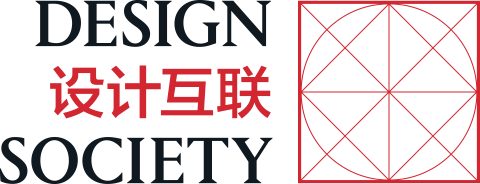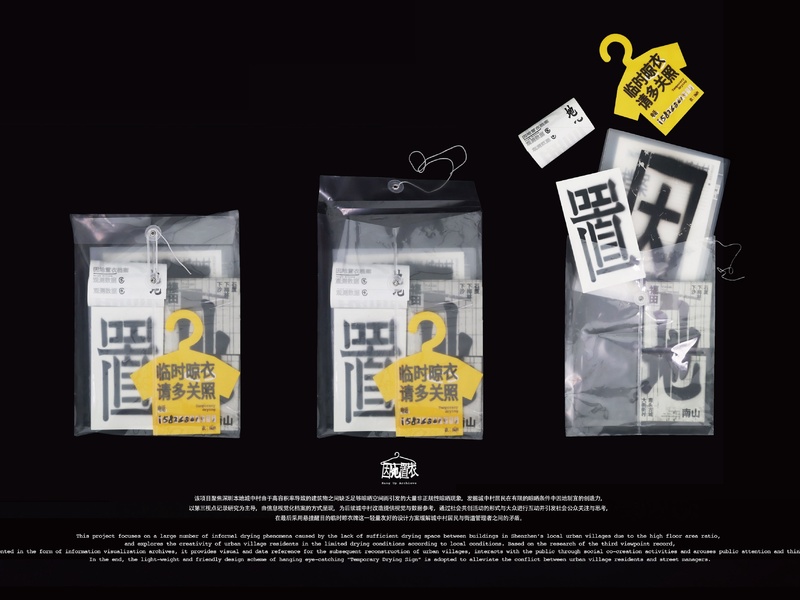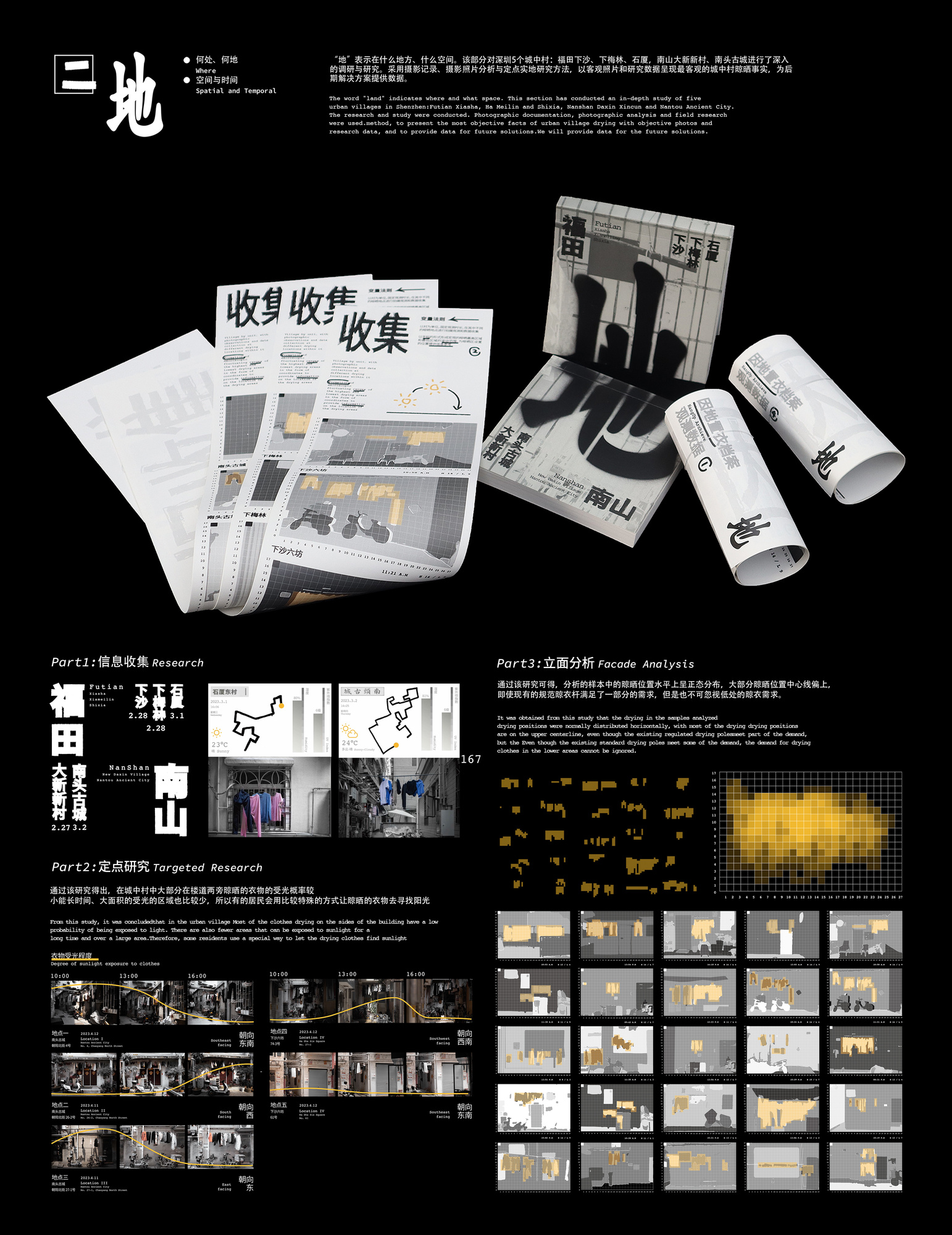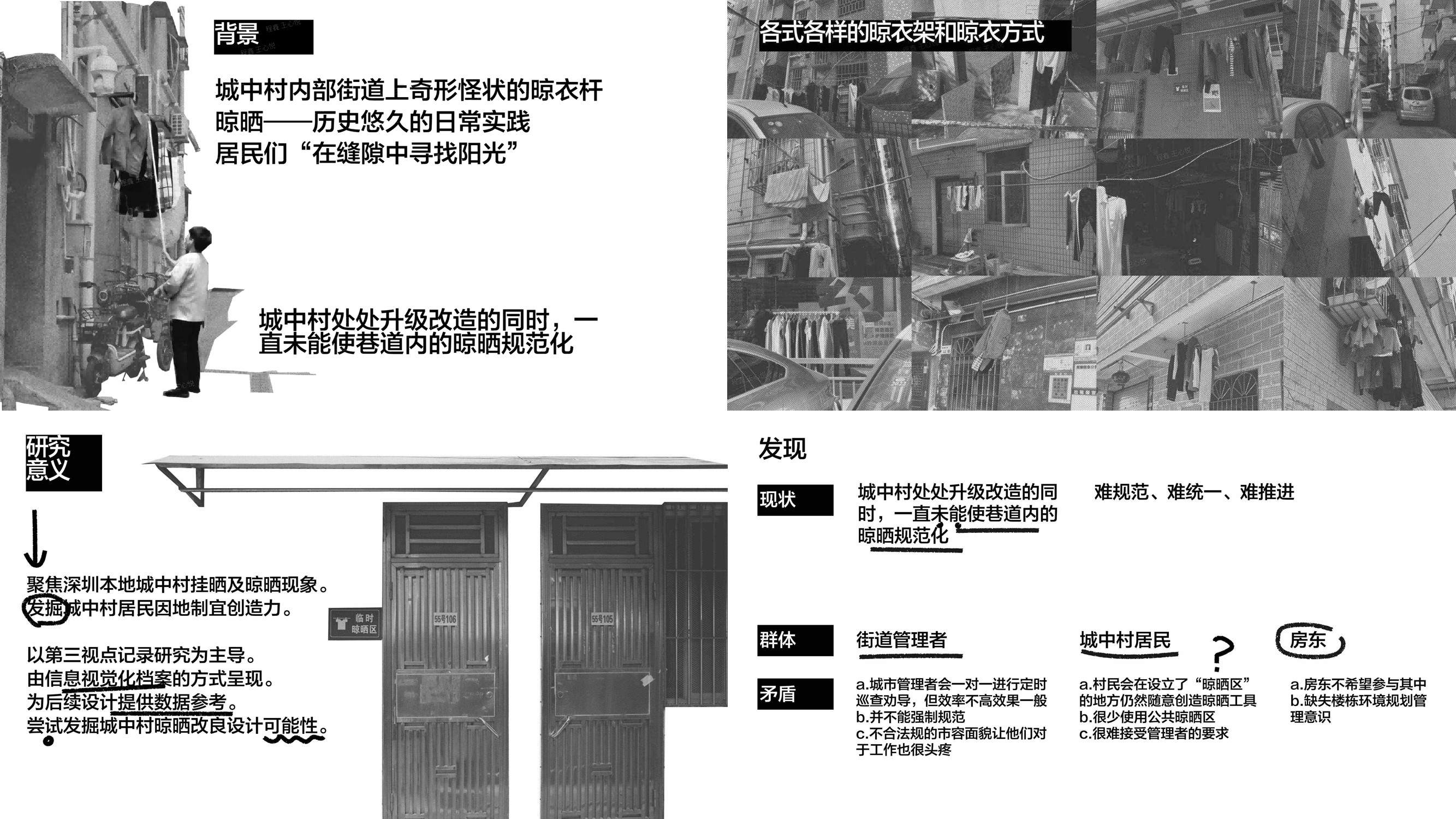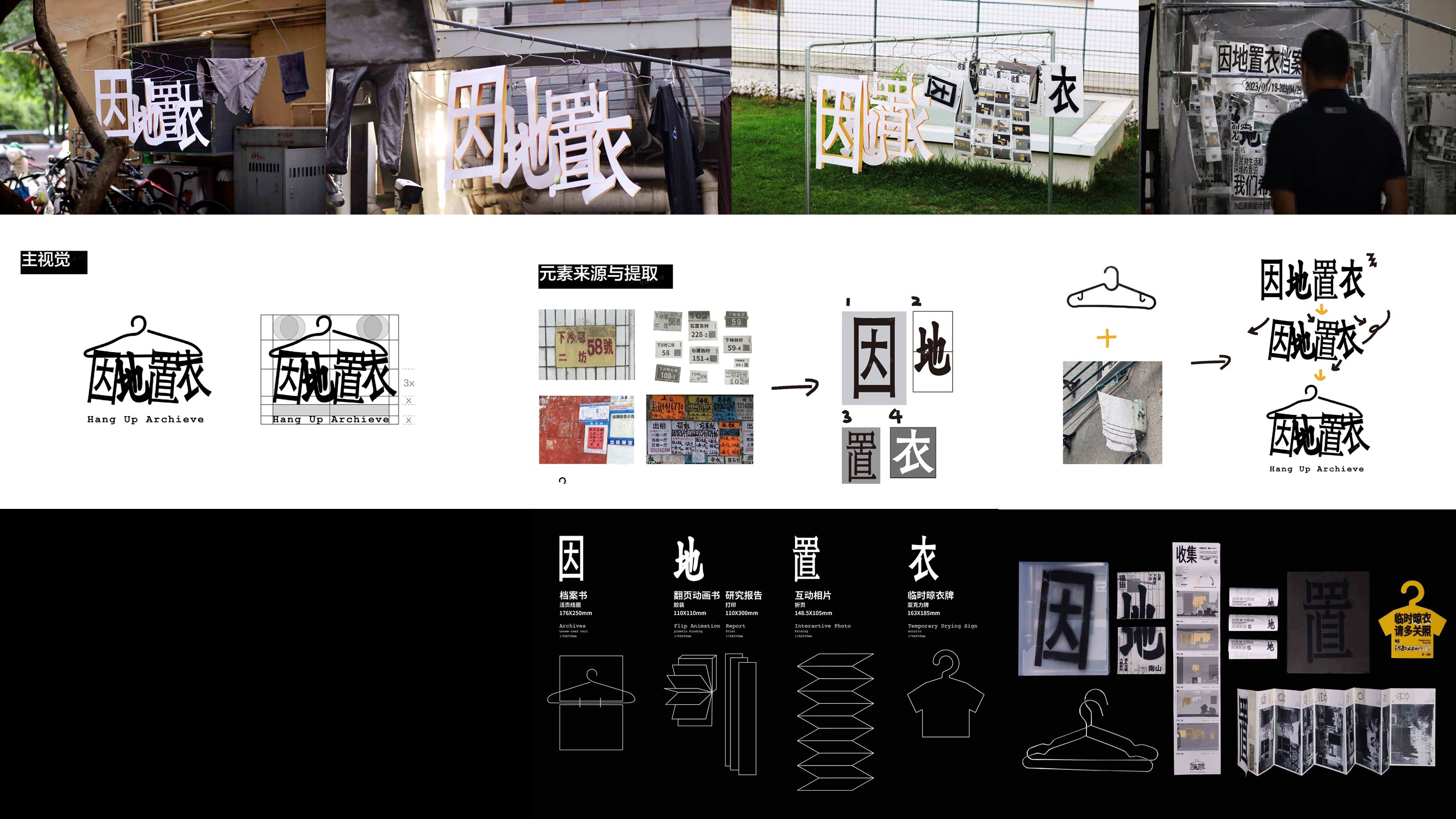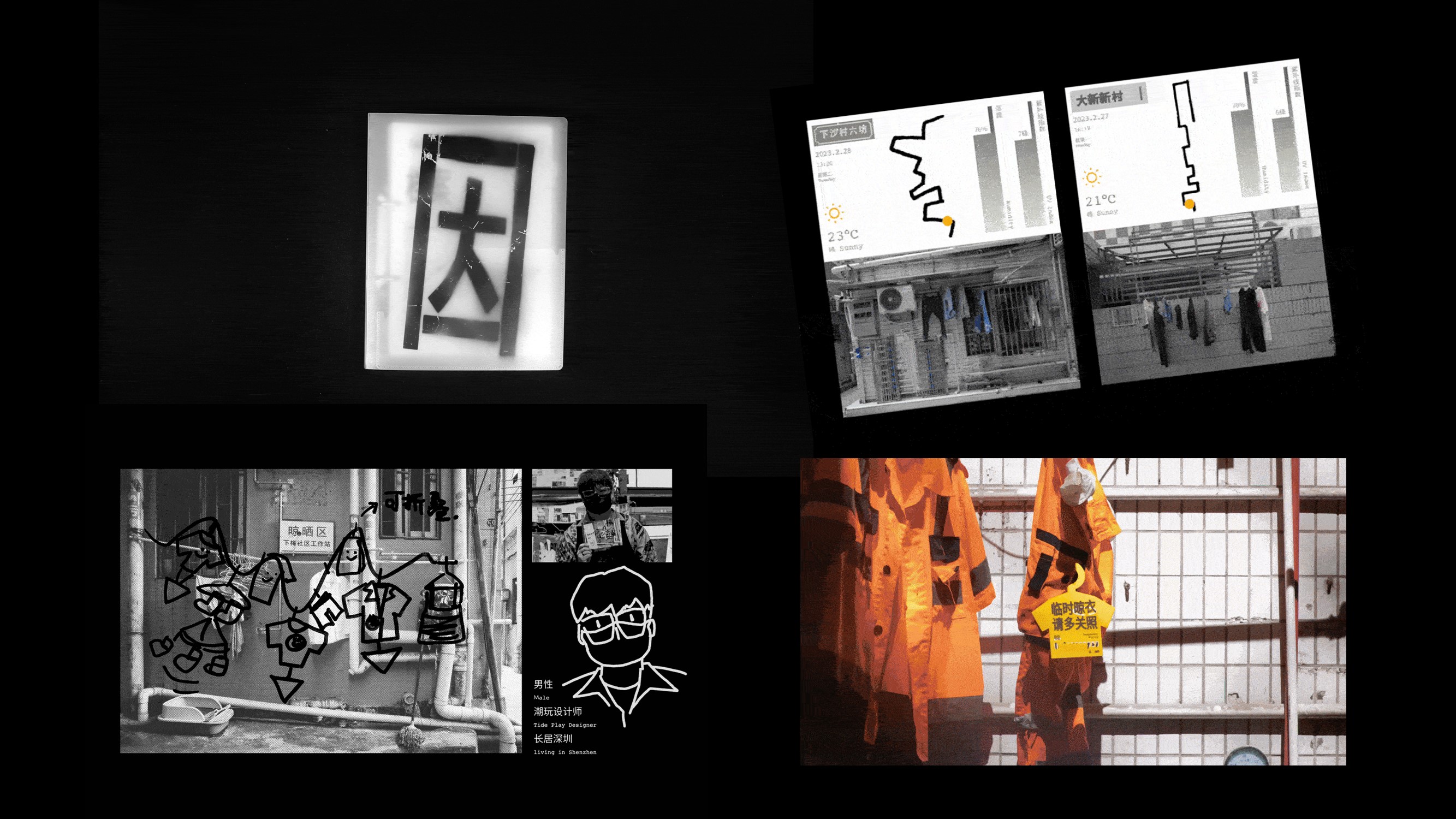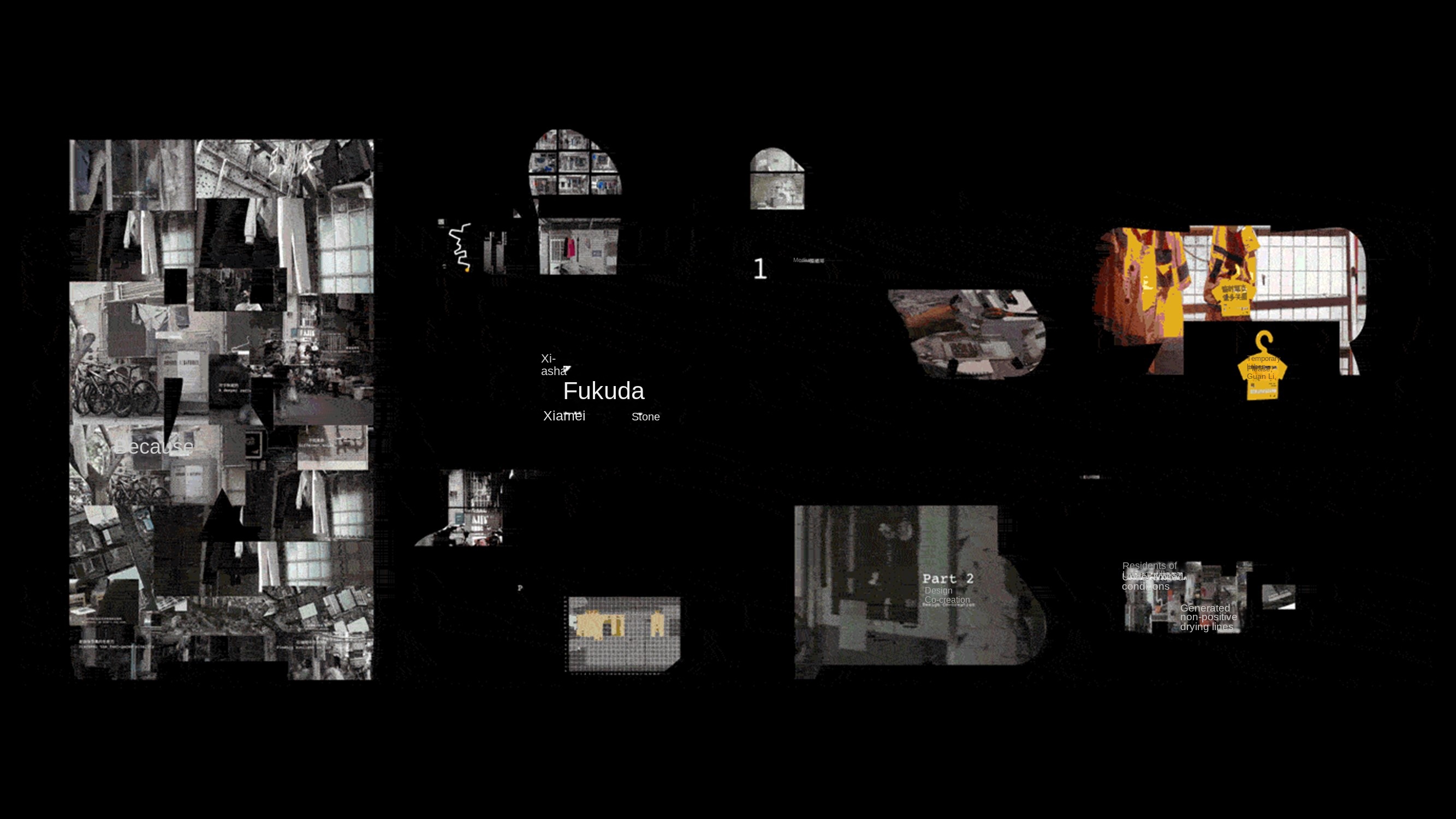Clothes due to the ground-drying visual files of villages in Shenzhen city
The project focuses on a large number of informal airing phenomena caused by the lack of sufficient airing space between buildings due to the high floor area ratio in local urban villages in Shenzhen,
Explore the creativity of urban village residents in the limited drying conditions.
Taking the third viewpoint record research as the leading factor, it is presented by the way of information visual archives, which provides visual and data reference for the subsequent transformation of urban villages,
Through the form of social co-creation activities to interact with the public and arouse public concern and thinking.
Finally, the light-weight and friendly design scheme of hanging eye-catching temporary clothes-airing board is adopted to alleviate the contradiction between urban village residents and street managers.
This project focuses on a large number of informal drying phenomena caused by the lack of sufficient drying space between buildings in Shenzhen's local urban villages due to the high floor area ratio, and explores the creativity of urban village residents in the limited drying conditions according to local conditions. Based on the research of the third viewpoint record, presented in the form of information visualization archives, it provides visual and data reference for the subsequent reconstruction of urban villages, interacts with the public through social co-creation activities and arouses public attention and thinking. In the end, the light-weight and friendly design scheme of hanging eye-catching “Temporary Drying Sign” is adopted to alleviate the conflict between urban village residents and street managers.
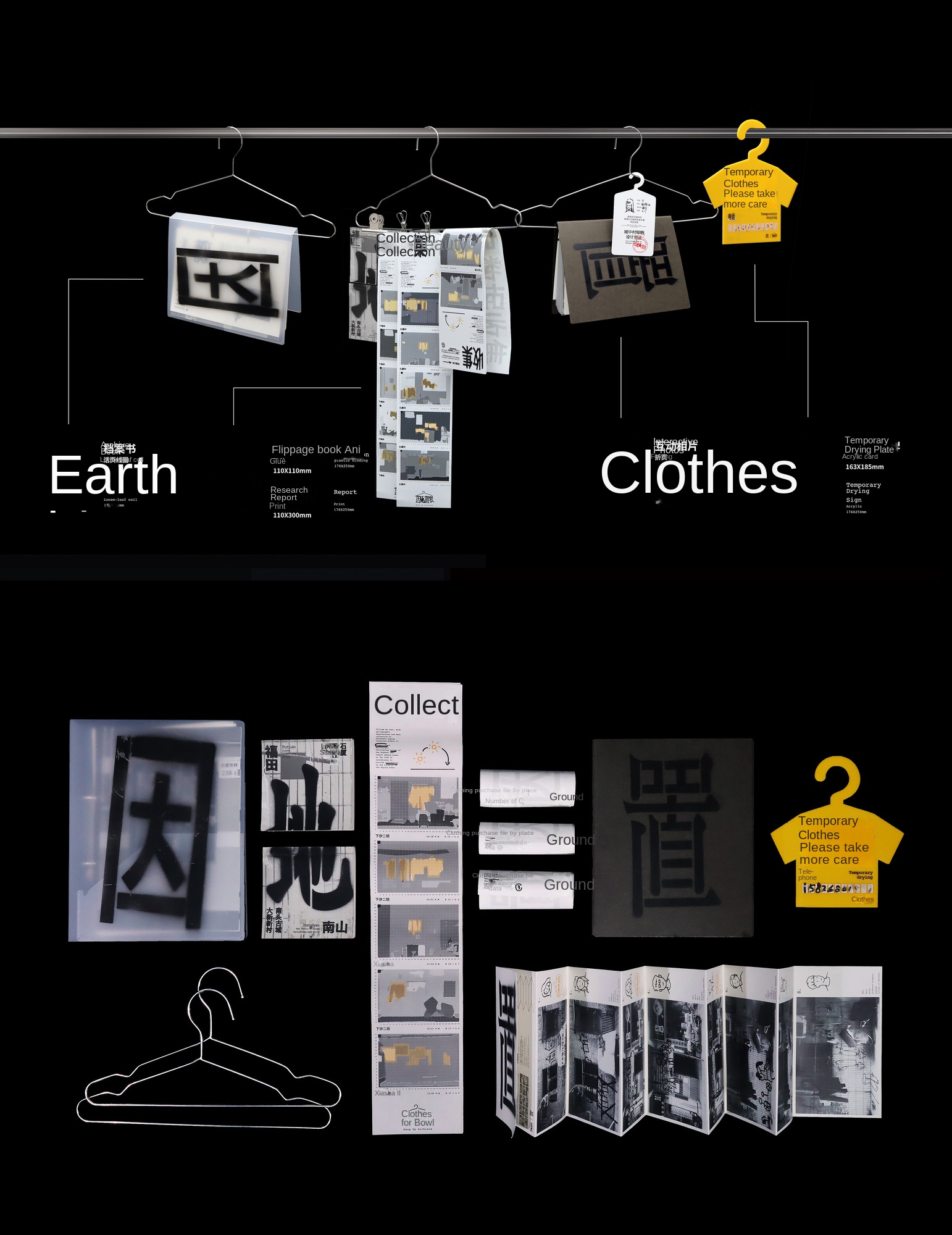
Clothes due to the ground-drying visual files of villages in Shenzhen city

Part 1:Cause
"Cause" means cause, cause,
This part mainly describes the initial reason and research process of the project to do the design project, from different perspectives, objectively face the existing situation,
On the one hand, the existing facts will be recorded to arouse the public's attention and thinking, as an introduction to the project,
On the one hand, it explores the behavior reasons of the residents of the village in the city and the grass-roots community personnel to the management norms of the village in the city.
This part mainly tells the starting reason and research process of this design project
starting from different perspectives, objectively facing the existing situation
On the one hand, it records the existing facts, arouses the attention and thinking of the public, and serves as the introduction of this project
On the other hand, it explores the reasons for the random drying of urban village residents and the behavior of grassroots community personnel in the management of urban village drying.

Part 2:Landscape
"The ground" means in what place, what space.
This part has conducted in-depth research and research on 5 urban villages in Shenzhen: Futian Xiasha, Xiameilin, Shixia, Nanshan Daxin New Village, and Nantou Ancient City.
The use of documentary photography analysis and fixed-point field research data to present the most objective urban village drying facts.
This section conducts in-depth research and study on five urban villages in Shenzhen:
Futian Xiasha, Xiameilin, Shixia, Nanshan Daxin Village, Nantou Ancient City.
Documentary photography analysis and fixed-point field research data are used
present the most objective facts about drying clothes in urban villages.
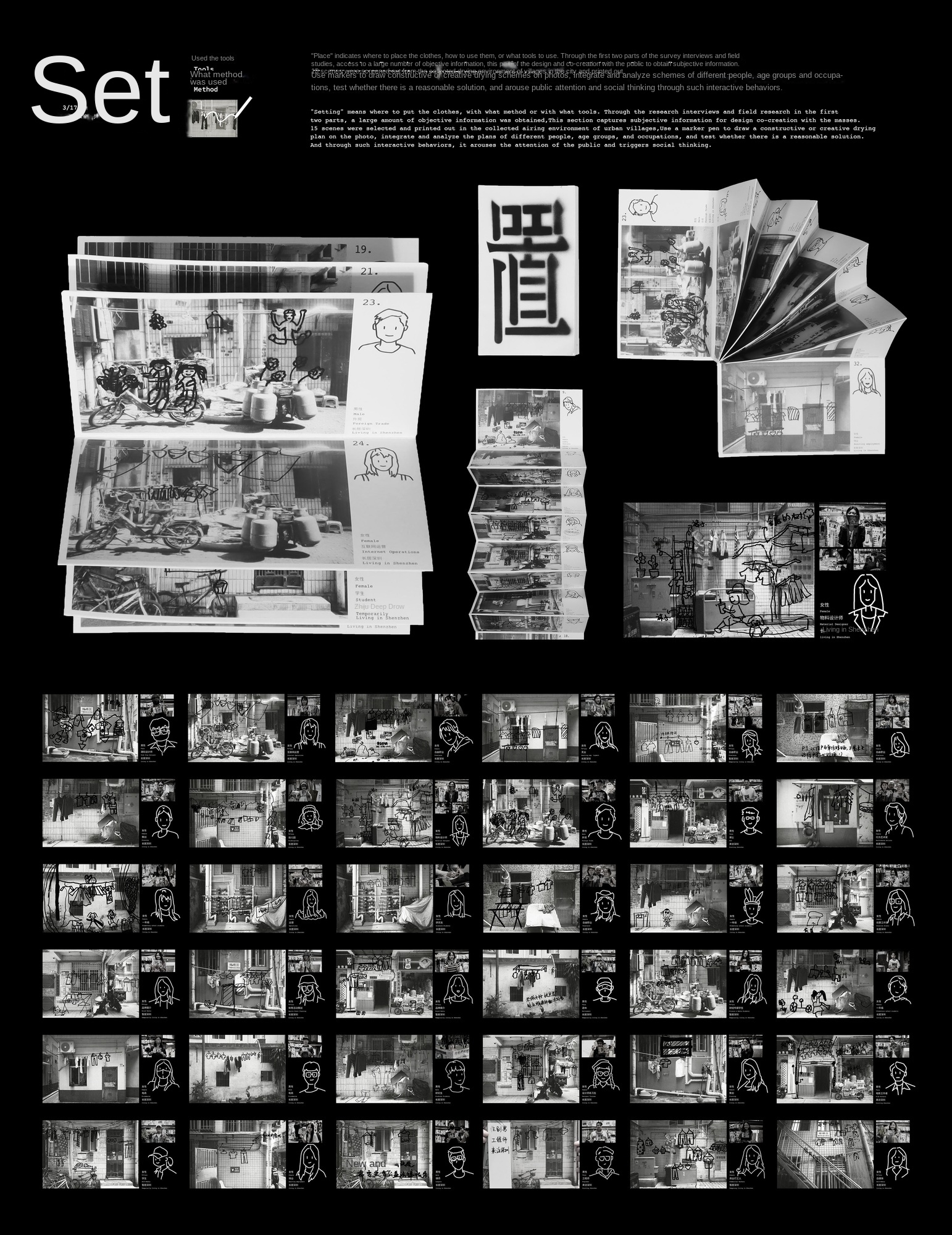
Part 3:Set
Place, indicating how or with what tools to place the clothes.
Through the first two parts of the survey interviews and field studies, access to a large number of objective information, this part of the design and co-creation with the public to obtain subjective information.
15 scenes were selected from the collected drying environment of villages in the city and printed out, and constructive or creative drying schemes were drawn on the photos with marker pens,
Through the collection of different people, age groups, occupational integration and analysis of the program,
Test whether there is a reasonable solution, and through such interactive behavior to attract public attention, triggering social thinking.
“Set” refers to how or what tools are used to put the clothes where.
Through the survey interviews and field research in the first two parts, a large amount of objective information was obtained. This part obtains subjective information through design co-creation with the public.
Fifteen scenes were selected from the collected drying environments in the urban villages and printed out.
Constructive or creative drying plans were drawn on the photos with markers.
By collecting plans from different groups, age groups, and occupations, they were integrated and analyzed.
The experiment was conducted to see if there was a reasonable solution, and to attract the attention of the public through such interactive behaviors, triggering social thinking.
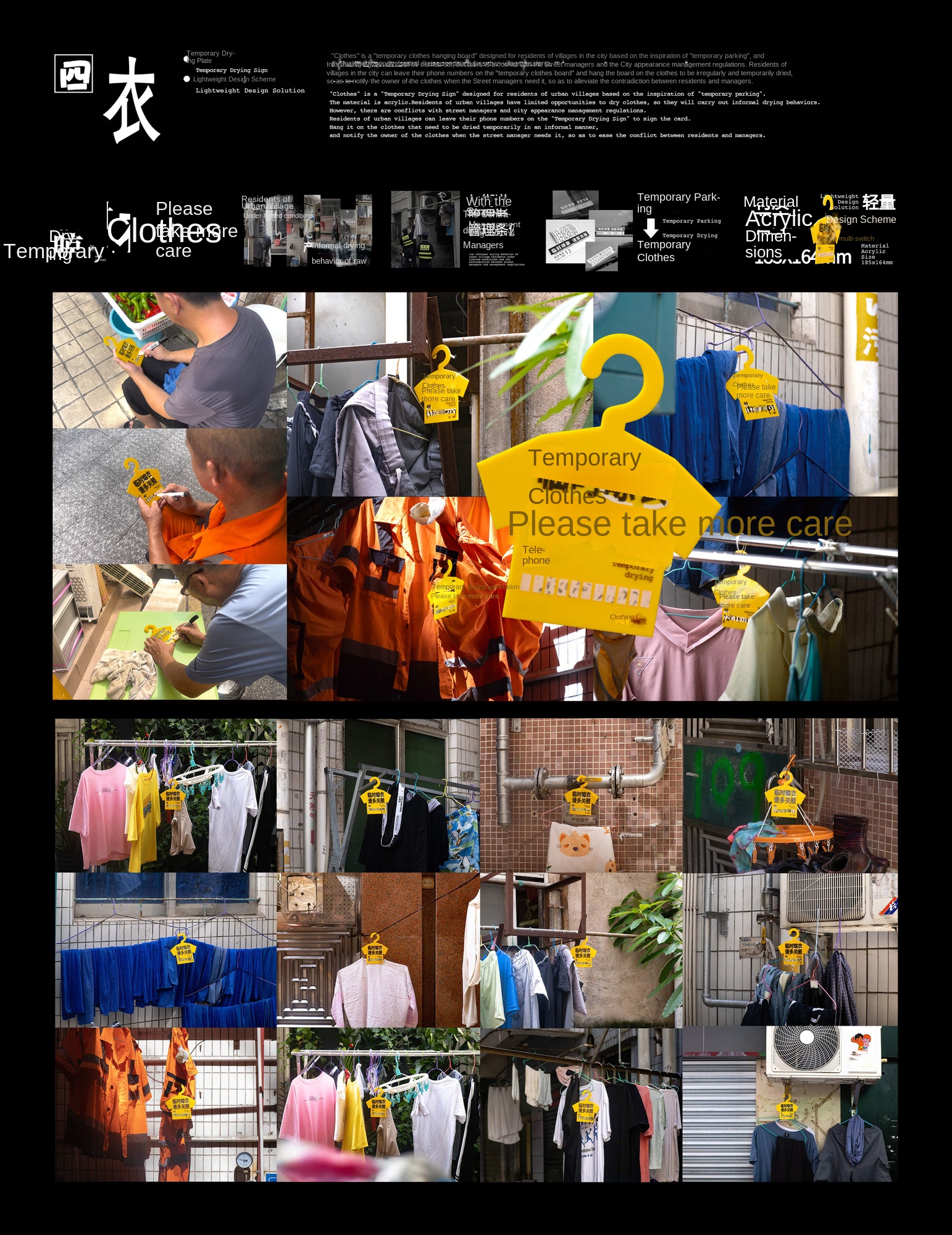
Part 4:Clothes clothing
"Yi" is based on the inspiration of "temporary parking" for the residents of the village in the city design "temporary clothes board"
Residents of urban villages will engage in informal drying under limited drying conditions, but they conflict with street managers and city appearance management regulations,
Residents of villages in the city can leave their phone number on the "temporary clothes board" and hang the board on the clothes that need to be aired irregularly and temporarily,
Notify the owner of the clothes when the street manager needs it to ease the contradiction between the residents and the manager.
"Clothes" is a "Temporary Drying Sign" designed for residents of urban villages based on the inspiration of "temporary parking ".
The material 13 acrylic.Residents of urban villages have luted opportunities to dry clothes, so they will carry out informal drying behaviors.
However, there are conflicts with street managers and city appearance management regulations.
Residents of urban villages can leave their phone nunbers on the "Temporary Drying sign" to sign the card.
Hang it on the clothes that need to be dried tenorary an an intorm manner.
and notify the owner of the clothes when the street manager needs it, so as to ease the conflict between residents and managers.
Supplementary information
The project focuses on a large number of informal drying phenomena caused by the lack of sufficient drying space between buildings due to high floor area ratio in local urban villages in Shenzhen, and explores the creativity of urban village residents in accordance with local conditions in the limited drying conditions. Led by the third point of view record research, presented by the way of information visual archives, it provides visual and data reference for the subsequent transformation of villages in the city, interacts with the public through the form of social co-creation activities and arouses public concern and thinking. Finally, the light-weight and friendly design scheme of hanging eye-catching temporary clothes-airing board is adopted to alleviate the contradiction between urban village residents and street managers.
This project focuses on a large number of informal drying phenomena caused by the lack of sufficient drying space between buildings in Shenzhen's local urban villages due to the high floor area ratio, and explores the creativity of urban village residents in the limited drying conditions according to local conditions. Based on the research of the third viewpoint record, presented in the form of information visualization archives, it provides visual and data reference for the subsequent reconstruction of urban villages, interacts with the public through social co-creation activities and arouses public attention and thinking. In the end, the light-weight and friendly design scheme of hanging eye-catching “Temporary Drying Sign” is adopted to alleviate the conflict between urban village residents and street managers.
Shenzhen's rapid development has left many villages in the city, becoming the best choice for low-cost housing. Residents are faced with the problem of drying in narrow alleyways, which has also inspired creative homemade clothes drying tools. They found new drying areas and homemade special tools. Despite the restrictions, residents do not allow their clothes to be wet, constantly looking for the best drying conditions, looking for sunlight in the gaps, and "placing (making) clothes (appropriate) according to the place" in the existing environment. This market wisdom contradicts the demands of managers to maintain the appearance of the city-the former regards it as an extension of the art of life, while the latter regards it as a potential safety hazard.
The overall work is presented in the way of books and documentary images. Books are bound by hand with loose-leaf books bought from stationery stores, and page-turning animation books are used to present the map path animation we investigated. Use the simplest marker to give the public to play the "drying designer" in the photos of villages in the city we print, and draw down the drying suggestions they think are reasonable; the spray-painted cover and the binding of the document bag deliberately retain the coarse handwork feeling, and the clothes rack is put into the book like the clothes drying site of the village in the city. Our research project expresses the research data in a dynamic way through documentary images and neutral perspectives, thus triggering thinking about the balance between humanistic spirit and institutional norms in urban governance.
His works have won the Merit Award of New York's Young One's ADC Design for Good; GDC Award Bronze Award for Social Practice; Top100 and so on were set up in the Design360 year and exhibited in the West Bank Art Center and the Maritime Culture and Art Center.
Shenzhen's urban villages, vital for affordable housing, showcase residents' ingenuity in adapting to limited spaces through creative drying solutions. While residents view these adaptations as practical living art, city managers see them as urban aesthetic and safety concerns. Our project explores this tension through handcrafted books and documentary visuals, using simple materials and public input to reflect the villages' resourcefulness. The project, recognized with awards like the Young One's ADC Design for Good Merit Award and the GDC Social Practice Bronze Award, has been exhibited at venues including the West Bund Art Center, highlighting the balance between grassroots innovation and urban governance.
The team all graduated from Shenzhen University with a bachelor's degree in visual communication design, Cheng Xin, a master's degree in visual communication design from Shenzhen University, and a research assistant at the National Image Research Center (NIRC) of Shenzhen University. He specializes in local cultural research and contemporary visual transformation, and is good at dynamic vision and cultural creative design. He has won 14 professional awards such as the Gold Award of the 5th Baoan Cultural and Creative Design Competition, the Bronze Award of the Hehu International Poster Exhibition, the KTK Jin Daiqiang Design Award, and the Platinum Creative Design Competition. Academic research focuses on visual narrative innovation in the context of digital media, and has achieved practical results. Wang Xinyue, a graduate student of Edinburgh University in the United Kingdom, mainly studies thinking transformation and typesetting innovation in the field of visual communication design. Team works have won international awards such as GDC23 Bronze Award, Design360 Top 100, New York Young one's ADC Excellence Award, etc.
